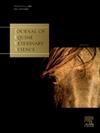Efficacy of an oral chondroprotective joint supplement on stride length and lameness in aged geldings with osteoarthritis
IF 1.6
3区 农林科学
Q2 VETERINARY SCIENCES
引用次数: 0
Abstract
With osteoarthritis (OA) diagnosed in over 50% of horses aged 15 years or older, there is a drive within the industry to prevent, mitigate, or repair joint damage. As such, oral joint supplements (OJS) are one of the most popular feed additives fed by horse owners. Though extensively reviewed in in vitro studies, conclusive evidence of the efficacy of these nutraceuticals in vivo has yet to be found. Hypothesizing that OJS do not improve signs of OA, this study aimed to investigate the impacts of OJS on equine lameness. To do so, 40 geldings (aged 18 ± 7 yr) with OA and AAEP lameness grades between 2 and 4 (as scored by a board-licensed veterinarian) were enrolled in the study. Horses were striated by lameness grade, BCS, and weight, and then were randomly assigned to receive a placebo powder or OJS containing glucosamine hydrochloride, methylsulfonylmethane, sodium chondroitin sulfate, and avocado/soybean unsaponifiables added to a ration balancer for 6 wk. Both the ration balancer and OJS were fed according to product instructions. Placebo and OJS groups were color-coded to ensure researchers remained blinded to treatment, and horses were assigned a random numeric identifier to prevent bias. Stride length (SL) measurements, flexion tests (FT), and lameness locator (LL) assessments were performed every 2 wk. Statistical analysis was performed using PROC MIXED in SAS 9.4 with the fixed effect of treatment, day, treatment by day, and random effect of horse. Day 0 was a significant covariate for LL data and was included in the model. There was no effect of treatment or treatment by day interaction for SL, though day affected both walk (P = 0.04) and trot (P < 0.01). However, across days, all changes in stride length were within 3% of baseline measurements. Similarly, there was no effect of treatment or the interaction of treatment by day for FT scores. Day affected FT scores, with the lowest average score on d 28 (P = 0.04). Analysis of lameness locator data showed no evidence of supplementation improving forelimb or hindlimb lameness over time, though hindlimb lameness tended to differ on d 14, with OJS horses having greater indication of lameness (P = 0.09). Thus, 6 wk of feeding an OJS did not impact stride length, lameness, or gait symmetry though values of each measure changed over time regardless of treatment. As such, there is no evidence to support efficacy of the tested OJS. These results emphasize the importance of well-controlled studies to determine the OJS efficacy in vivo and support the continued development of evidence-based management strategies for horses diagnosed with OA.
口服软骨保护关节补充剂对老年骨性关节炎马跨步长度和跛行的影响
随着超过50%的15岁或以上的马被诊断为骨关节炎(OA),业内有一种预防、减轻或修复关节损伤的动力。因此,口服联合补充剂(OJS)是最受马主欢迎的饲料添加剂之一。尽管在体外研究中进行了广泛的审查,但尚未发现这些营养保健品在体内功效的确凿证据。假设OJS不能改善OA症状,本研究旨在探讨OJS对马跛行的影响。为此,研究人员招募了40匹(18±7岁)OA和AAEP跛行等级在2到4之间(由注册兽医评分)的阉马(18±7岁)。根据马的跛行等级、BCS和体重进行分层,然后随机分配给马服用安慰剂粉或含有盐酸氨基葡萄糖、甲基磺酰甲烷、硫酸软骨素钠和牛油果/大豆不皂化物的OJS,并将其添加到定量平衡器中,持续6周。定量平衡器和OJS都按照产品说明书进行投料。安慰剂组和OJS组用颜色编码,以确保研究人员对治疗不知情,马被随机分配一个数字标识符,以防止偏见。每2周进行一次步长(SL)测量、屈曲测试(FT)和跛行定位器(LL)评估。采用SAS 9.4中的PROC MIXED进行统计学分析,固定效应为治疗、日、逐日治疗,随机效应为马。第0天是LL数据的显著协变量,并被纳入模型。治疗或日间交互治疗对SL没有影响,尽管日间对步行(P = 0.04)和小跑(P <;0.01)。然而,在几天内,所有步幅的变化都在基线测量值的3%以内。同样,治疗或日间治疗对FT评分没有影响。日对FT评分有影响,平均评分在第28天最低(P = 0.04)。对跛行定位器数据的分析显示,没有证据表明补充剂可以随着时间的推移改善前肢或后肢跛行,尽管后肢跛行在第14天有所不同,OJS马有更大的跛行迹象(P = 0.09)。因此,饲喂OJS 6周不会影响步幅、跛行或步态对称性,尽管无论治疗方式如何,每个测量值都会随着时间的推移而改变。因此,没有证据支持测试的OJS的有效性。这些结果强调了良好对照研究的重要性,以确定OJS在体内的疗效,并支持对诊断为OA的马的循证管理策略的持续发展。
本文章由计算机程序翻译,如有差异,请以英文原文为准。
求助全文
约1分钟内获得全文
求助全文
来源期刊

Journal of Equine Veterinary Science
农林科学-兽医学
CiteScore
2.70
自引率
7.70%
发文量
249
审稿时长
77 days
期刊介绍:
Journal of Equine Veterinary Science (JEVS) is an international publication designed for the practicing equine veterinarian, equine researcher, and other equine health care specialist. Published monthly, each issue of JEVS includes original research, reviews, case reports, short communications, and clinical techniques from leaders in the equine veterinary field, covering such topics as laminitis, reproduction, infectious disease, parasitology, behavior, podology, internal medicine, surgery and nutrition.
 求助内容:
求助内容: 应助结果提醒方式:
应助结果提醒方式:


